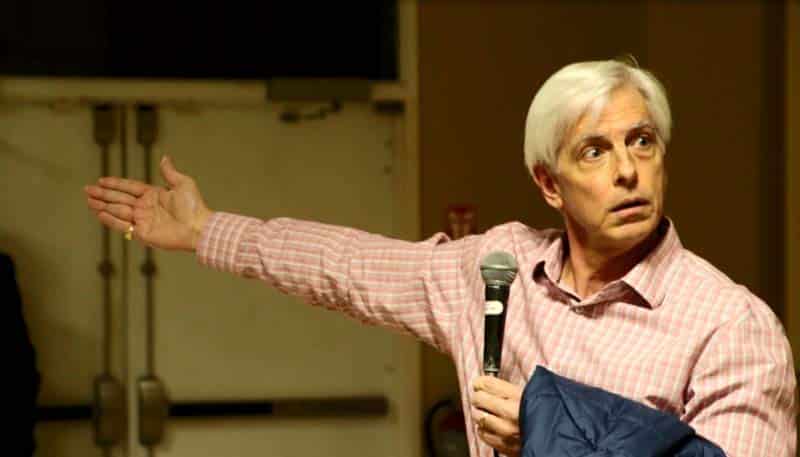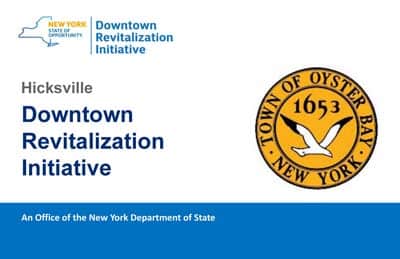Final DRI meeting set for March 15

How do Hicksville residents feel about their downtown?
The New York State-funded Downtown Revitalization Initiative (DRI) process has yielded numerous opinions during the five meetings of the Local Planning Committee (LPC) and three public workshops. Few of them were favorable, as these selected quotes show:
“There is no ‘place’ I would like to spend time in!”
“Why does downtown Hicksville have to feel like a parking lot?”
“I can’t walk anywhere without risking life and limb.”
“None of the commuters who use ‘our station’ spend any money in Hicksville.”
The final public workshop took place Feb. 26, and on March 15, the LPC will meet for the final time to choose the strategic investment plan with the proposed projects it will present to the state.
Most will be in town-owned property, with the idea that improvements there will spur private development.

After deducting $300,000 to fund the planning/design aspect of the initiative, the state will finance $9.7 million to begin the transformation of a downtown/railroad station area that, in the minds of many, has not fulfilled its potential.
The timetable calls for the state to announce the DRI project awards early this summer. The projects will then begin to take shape in the winter of 2019.
Project List
The following are projects the LPC is expected to recommend:
- New LIRR Station Entry Drive: Corner of West John Street and Wyckoff Place. Involves a complicated redesign and rerouting of the area to decongest traffic and create safe walking and commuter drop-off areas. The most distinctive feature will be a protective canopy. DRI funding expectation: $4.3 million.
- New Station Plaza: Adjacent to the Entry Drive. Located at Newbridge Road and Wyckoff Street north of the railroad and south of West Barclay Street. Aim is to decongest the area and create a safe and public space attractive to commuters and residents. DRI funding: $3 million.
- Festival Plaza: Create a new open space north of the LIRR tracks between Newbridge Road and Jerusalem Avenue. Will support seasonal, temporary activities (farmers’ markets, musical entertainment, etc.) that will draw visitors. DRI funding: $3.2 million.
- 99 Hicksville Station Plaza. Private developer proposes 200 apartments above retail spaces, along with enclosed parking. On Newbridge Road and Duffy Avenue extending along Nelson Avenue. Private investment of $40-45 million, with investor seeking $1.5 million in DRI funding.
- Underline: Will seek $1 million to transform the space under the railroad tracks as part of enhancing public spaces.
- A $75,000 grant to Trinity Lutheran Church and School Day Care Facility for an expansion plan at its West Nicholai Street location,
- A $600,000 small business development fund to promote and support small operations in the area.

Public To Private
Town of Oyster Bay Supervisor Joseph Saladino reminded attendees that the state moneys were merely the catalyst to spur the kind of “great change that residents want.”
He added, “Residents are the driving force, and the most important part of the puzzle. All of your input has been critical to making sure that we have success in the process….And we will continue to listen to you and work with you to make sure that it’s done properly.”
The supervisor reminded residents that the DRI is not a “one and done.” The process will continue as private developers will then begin to spend money to add an expected one million square feet of developed space. This is the outcome hoped for after the town changes its zoning to encourage mixed-used development, with residential above retail and parking garages as part of the new structures.
The town will begin the process of turning some of the many surface parking lots it owns into green/public spaces that will enhance traffic flow and make the area pedestrian-friendly.
In short, the DRI seeks to make concrete what more than a decade of planning and discussion by concerned citizens had envisioned: a vibrant retail/housing/entertainment destination to draw residents and visitors.

Consultant Weighs In
Cecil Bakalor, of the design firm and consultant HKS, told residents he was aware of how often they had been disappointed.
“[The DRI] is a chance for something to happen,” he said. “To see this kind of enthusiasm is very special.”
Bakalor said there were three kinds of traffic to deal with: through traffic on state routes 106 and 107, traffic to and from the railroad station, and local traffic.
The DRI proposal was to lower the speed limit in the station area and put in enhanced pedestrian crossings.
“Right now you have 40 miles an hour traffic racing through Hicksville,” he pointed out. “Quite honestly, the only way to make pedestrians feel safe is to stop the traffic. The speed limit will be enforced and traffic will stop at crossings. It’s the only answer.”
Bakalor noted that the proposed parking structures north of the station will free up surface parking lots for new development, as well as free up land for the proposed public spaces where people can gather and want to spend time in.
The designer envisioned a scenario where many of the commuters will want to stay and use downtown after returning from the city. In addition, transit-oriented housing will infuse new energy and stimulus to the area.
A quick survey by Saladino to get a sense of which projects were favored showed that many liked the $4.3 million Entry Drive that turned Wyckoff Place into a road where cars could quickly drop off commuters. Adjacent to it would be a Station Plaza for gatherings. The latter also gained a majority nod.
Bakalor called the Entry Drive “a front door you could be proud of. It’s a place that does not feel like ‘asphalt and parking.’”
He also talked about the underline—the space under the railroad trestle, calling it “ghastly.”
He added, “We see a lot of potential here,” mentioning the possibility of lighting and artwork.
Yet another of the proposed ideas was the expansion of the existing Trinity Lutheran Church and School Day Care facility. Bakalor noted that it “fits in with the larger goals of the project, with its plans to keep young people in Hicksville—and they need day care.”

The People Speak
Richard Pfaender, a 65-year resident, stated, “This is the first time it looks like we’re going to do something.”
But he warned that with so much of the proposed projects area being in the public sphere, it would behoove the LPC to make sure it had agreements in place with the MTA and state DOT regarding maintenance.
“We have an opportunity for the first time with real money on the table,” he said. “This isn’t for me—at 68, I won’t be around forever. This is to be able to say that we passed something on to the next generation.”
Joel Bearse said he had dealings with the MTA during his time on the town’s civic boards. Regarding one of the proposed projects—the underline—he observed that the agency had rejected every proposal to do something under its trestle.
“That would be something to negotiate with them,” he advised.
Adam Firester said that he loved the vision, and during the transformation hoped that the town would preserve at least the same number of parking spots that currently exist.
Gregory Carman Jr., the LPC co-chair and Oyster Bay deputy supervisor, assured him that his concern has “been one of the main topics of conversation as we look at how we’ll timeline this development of the different aspects of the downtown area.”
George Sahaidachny said, “I love the idea and this whole proposal. I hope that it happens. But my main concern is, what are they going to do with the existing traffic?”
Bakalor said one of the suggestions had been to lower the speed limit and reroute traffic flows to the future parking garages.
To Sahaidachny, it all sounded “pie in the sky….What are you going to do? Put more traffic on West John Street or Woodbury Road?”
With the addition of transit-oriented housing, he said, “They are adding more and more people. Don’t tell me [this means] less traffic. That’s baloney, I don’t buy it.”
Charles Stein agreed that traffic was an intractable problem. He mentioned the plan by the MTA to add a net 900 parking spaces.
“How is that going to do anything for traffic—other than to increase it?” he stated. “Am I missing something?”
“Exactly!” someone called out.
A man stood up and asked about the proposed developed further north at the Sears property and how it would affect the DRI.
Responded Saladino, “A lot of people have expressed concerns about that. Ultimately, the town will be able to approve or deny what is going to be proposed at the Sears property. We’re very cognizant of that.”
He added that the DRI was his administration’s first major project and he assured residents that it would not destroy the hamlet.
Another resident expressed the hope that the project would employ sustainable development guidelines, and Saladino assured her it would, as the state was promoting green tech and green energy. He mentioned solar panels and rain collection barrels to water the flora in the public spaces.
“This is a fabulous opportunity to go full throttle in a green direction,” the supervisor stated.
Longtime resident Rich Budinich mentioned several projects in the hamlet that the town had “screwed up.”
“Hicksville has been a dumping ground,” he stated. “Now we have a committee that’s done a great job. It’s going to hold [elected officials’] feet to the fire.”
Jeff Negron, president of the Northwest Civic Association of Hicksville, was skeptical about the plans to slow traffic down—though he favored it in terms of pedestrian safety.
LPC member Ryan Coyne responded that “every traffic study done in the past 15 years shows that slower, more consistent traffic brings less congestion. Right now everybody’s accelerating or slamming on the brakes…that leads to more accidents and pedestrian fatalities.”
Negron also asked about the proposed closing of a portion of Jerusalem Avenue as part of the Kennedy Memorial Park expansion. How would that affect traffic flow? he wondered.
“We’re talking about adding options that are more efficient and safer for both cars and pedestrians,” Coyne replied. “It’s not about one or the other.”
A woman asked about the possibility of tax abatements for future private projects, and their implications.
Saladino told her that her question “has come up in our meetings and discussions. We realize the balance that’s going on here, whether it’s about what happens with parking, whether it’s the parking issues or the revenue. You have to consider what the ramifications are.”
Saladino observed, “When I hear the phrase, ‘Have you considered?’ the answer is ‘Yes.’ We’re working with experts who’ve done these projects throughout the state to get their input. We have people with all kinds of expertise, from construction to finance. The answer to your question is yes, we are considering the ramifications with each decision that’s being made, so that we don’t mess it up.”
 Final Words
Final Words
“It’s important to remember the past so we don’t make the same mistakes going forward” Saladino said. “That’s why we’re here tonight listening. Not to do something in some back room—and then everybody has to live with it. We’re listening to you. We want to build what you want….We’re happy leaving the lines of communication open. People’s questions can be answered, their fears can be allayed.”
Saladino informed attendees that Governor Andrew Cuomo “has been following what we’re doing very closely. And he has related to us that he’s very proud of the progress we’re making and proud of the way this progress is going.”
He added, “Part of the process is to negotiate throughout with the MTA and others to make sure we address all the concerns. We have a great team of people who are negotiating for you the residents to make sure everything is addressed—and I’m a stickler for details.”
Gregory observed, “I think it’s the best crowd we’ve had and it’s great to see the turnout tonight.”
The final public meeting of the LPC is Thursday, March 15, at 7 p.m. at the Hicksville Community Center, 28 West Carl St., Hicksville.


















